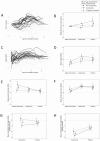Characteristics of Growth in Children With Classic Congenital Adrenal Hyperplasia due to 21-Hydroxylase Deficiency During Adrenarche and Beyond
- PMID: 34599587
- PMCID: PMC8764343
- DOI: 10.1210/clinem/dgab701
Characteristics of Growth in Children With Classic Congenital Adrenal Hyperplasia due to 21-Hydroxylase Deficiency During Adrenarche and Beyond
Abstract
Context: Patients with classic congenital adrenal hyperplasia (CAH) often do not achieve their full growth potential. Adrenarche may accelerate bone maturation and thereby result in decreased growth in CAH.
Objective: The study aimed to analyze the impact of growth during adrenarche on final height of adequately treated classic CAH patients.
Methods: This retrospective, multicenter study (4 academic pediatric endocrinology centers) included 41 patients with classical CAH, born 1990-2012. We assessed skeletal maturation (bone age), growth velocity, and (projected) adult height outcomes, and analyzed potential influencing factors, such as sex, genotype, and glucocorticoid therapy.
Results: Patients with classic CAH were shorter than peers (-0.4 SDS ± 0.8 SD) and their parents (corrected final height -0.6 SDS ± 1.0 SD). Analysis of growth during adrenarche revealed 2 different growth patterns: patients with accelerating bone age (49%), and patients with nonaccelerating bone age relative to chronological age (BA-CA). Patients with accelerating BA-CA were taller than the normal population during adrenarche years (P = 0.001) and were predicted to achieve lower adult height SDS (-0.9 SDS [95% CI, -1.3; -0.5]) than nonaccelerating patients when assessed during adrenarche (0.2 SDS [95% CI, -0.3; 0.8]). Final adult height was similarly reduced in both accelerating and nonaccelerating BA-CA groups (-0.4 SDS [95% CI, -0.9; 0.1] vs -0.3 SDS [95% CI, [-0.8; 0.1]).
Conclusion: Patients with and without significant bone age advancement, and thus differing height prediction during adrenarche, showed similar (predicted) final height when reassessed during pubertal years. Bone age alone should not be used during adrenarche as clinical marker for metabolic control in CAH treatment.
Keywords: adrenarche; classic CAH; final height prediction; growth.
© The Author(s) 2021. Published by Oxford University Press on behalf of the Endocrine Society.
Figures




Similar articles
-
Growth pattern of untreated boys with simple virilizing congenital adrenal hyperplasia indicates relative androgen insensitivity during the first six months of life.Horm Res Paediatr. 2011;75(4):264-8. doi: 10.1159/000322580. Epub 2010 Dec 22. Horm Res Paediatr. 2011. PMID: 21196707
-
Growth patterns and final height in congenital adrenal hyperplasia due to classical 21-hydroxylase deficiency. Results of a multicenter study.Horm Res. 2001;55(4):161-71. doi: 10.1159/000049990. Horm Res. 2001. PMID: 11598369 Review.
-
Obesity among children and adolescents with classic congenital adrenal hyperplasia due to 21-hydroxylase deficiency.Pediatrics. 2006 Jan;117(1):e98-105. doi: 10.1542/peds.2005-1005. Pediatrics. 2006. PMID: 16396852
-
The urinary steroidome of treated children with classic 21-hydroxylase deficiency.J Steroid Biochem Mol Biol. 2017 Jan;165(Pt B):396-406. doi: 10.1016/j.jsbmb.2016.08.006. Epub 2016 Aug 17. J Steroid Biochem Mol Biol. 2017. PMID: 27544322
-
Long-term prednisone versus hydrocortisone treatment in children with classic Congenital Adrenal Hyperplasia (CAH) and a brief review of the literature.Acta Biomed. 2019 Sep 6;90(3):360-369. doi: 10.23750/abm.v90i3.8732. Acta Biomed. 2019. PMID: 31580328 Free PMC article. Review.
Cited by
-
Monitoring treatment in pediatric patients with 21-hydroxylase deficiency.Front Endocrinol (Lausanne). 2023 Feb 3;14:1102741. doi: 10.3389/fendo.2023.1102741. eCollection 2023. Front Endocrinol (Lausanne). 2023. PMID: 36843618 Free PMC article. Review.
-
Growth Assessment and Nutritional Status in Children with Congenital Adrenal Hyperplasia-A Cross-Sectional Study from a Vietnamese Tertiary Pediatric Center.Diagnostics (Basel). 2025 Jun 16;15(12):1534. doi: 10.3390/diagnostics15121534. Diagnostics (Basel). 2025. PMID: 40564853 Free PMC article.
-
Cardiometabolic Aspects of Congenital Adrenal Hyperplasia.Endocr Rev. 2025 Jan 10;46(1):80-148. doi: 10.1210/endrev/bnae026. Endocr Rev. 2025. PMID: 39240753 Free PMC article. Review.
References
-
- Hargitai G, Sólyom J, Battelino T, et al. ; MEWPE-CAH Study Group . Growth patterns and final height in congenital adrenal hyperplasia due to classical 21-hydroxylase deficiency. Results of a multicenter study. Horm Res. 2001;55(4):161-171. - PubMed
-
- Allen DB. Growth suppression by glucocorticoid therapy. Endocrinol Metab Clin North Am. 1996;25(3):699-717. - PubMed
-
- Bonfig W, Bechtold S, Schmidt H, Knorr D, Schwarz HP. Reduced final height outcome in congenital adrenal hyperplasia under prednisone treatment: deceleration of growth velocity during puberty. J Clin Endocrinol Metab. 2007;92(5):1635-1639. - PubMed
-
- Hindmarsh PC. Management of the child with congenital adrenal hyperplasia. Best Pract Res Clin Endocrinol Metab. 2009;23(2):193-208. - PubMed

